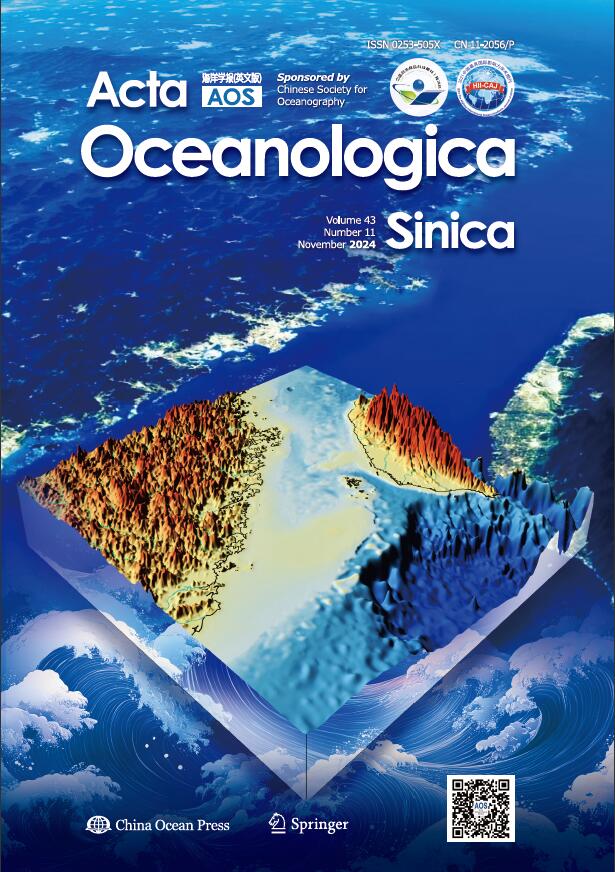1996 Vol. 15, No. 4
Display Method:
1996, (4): 423-435.
Abstract:
A modified inverse method is used to compute the circulations east of Taiwan and in the East China Sea and east of the Ryūkyū Islands with hydrographic data obtained during early summer of 1985. The computational region covers an area west of 129°E a...
A modified inverse method is used to compute the circulations east of Taiwan and in the East China Sea and east of the Ryūkyū Islands with hydrographic data obtained during early summer of 1985. The computational region covers an area west of 129°E a...
1996, (4): 437-445.
Abstract:
Based on the remote sensing information and related condition such as geology, geomorphology, hydrology and meteorology, a remote sensing expert system of the South China Sea coral reefs is developed by using a new remote sensing twin-tree structure....
Based on the remote sensing information and related condition such as geology, geomorphology, hydrology and meteorology, a remote sensing expert system of the South China Sea coral reefs is developed by using a new remote sensing twin-tree structure....
1996, (4): 447-455.
Abstract:
The CO2 exchange between atmosphere and seawater has been discussed. The physical process of exchange at seasurface is related closely with the atmospheric forcing. The result of a dynamics analysis of the CO2 flux actvas the seasurface, and a comput...
The CO2 exchange between atmosphere and seawater has been discussed. The physical process of exchange at seasurface is related closely with the atmospheric forcing. The result of a dynamics analysis of the CO2 flux actvas the seasurface, and a comput...
1996, (4): 457-468.
Abstract:
The analysis on the magnetic fabric of profile of the sedimentary core taken in five stations in the small spreading ridge area in Mariana Trough shows that the effect of indicating its depositional fabric, sedimentary rhythm, sedimentary events, sed...
The analysis on the magnetic fabric of profile of the sedimentary core taken in five stations in the small spreading ridge area in Mariana Trough shows that the effect of indicating its depositional fabric, sedimentary rhythm, sedimentary events, sed...
1996, (4): 469-492.
Abstract:
Microtextures and structures of 9 hydrothermal chimneys sampled on the small spreading ridge of the Mariana Trough during SONNE Cruise 57 (5057) and 69 (5069) in 1988 and 1990 were studied by means of scanning electron microscope. The results reveal ...
Microtextures and structures of 9 hydrothermal chimneys sampled on the small spreading ridge of the Mariana Trough during SONNE Cruise 57 (5057) and 69 (5069) in 1988 and 1990 were studied by means of scanning electron microscope. The results reveal ...
1996, (4): 493-513.
Abstract:
The section of Yujiawaizi Loess in Dalian, one of the typical sections of China's coastal loess, revealed three reliable polarity reversal events, i.e.,Mungo Event (27.5-23.7 ka BP), Laschamp Event (43.5-37.3 ka BP) and Blake Event (125. 4-110.5 ka B...
The section of Yujiawaizi Loess in Dalian, one of the typical sections of China's coastal loess, revealed three reliable polarity reversal events, i.e.,Mungo Event (27.5-23.7 ka BP), Laschamp Event (43.5-37.3 ka BP) and Blake Event (125. 4-110.5 ka B...
1996, (4): 515-527.
Abstract:
This paper deals with, comprehensively, for the first time, the species composition, number and its distributional characteristics of polychaetes in the soft bottom in the west of the Taiwan Stnut. This paper is sorted out on the basis of the data fr...
This paper deals with, comprehensively, for the first time, the species composition, number and its distributional characteristics of polychaetes in the soft bottom in the west of the Taiwan Stnut. This paper is sorted out on the basis of the data fr...
1996, (4): 529-538.
Abstract:
By air-dry method, the karyotype from gill cell in three clams of Bivalvia Pterimorphia Arcidae,Tegillarca granosa, Scapharca subcrenata and S. broughtonii. Was studied. Their chromosome number(2n) and fundamental number (NF) are equal to each other....
By air-dry method, the karyotype from gill cell in three clams of Bivalvia Pterimorphia Arcidae,Tegillarca granosa, Scapharca subcrenata and S. broughtonii. Was studied. Their chromosome number(2n) and fundamental number (NF) are equal to each other....
1996, (4): 539-556.
Abstract:














